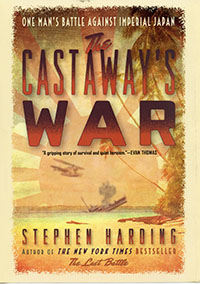 What a pleasure it is to encounter a book that is exhaustively researched, scrupulously foot-
What a pleasure it is to encounter a book that is exhaustively researched, scrupulously foot-
noted, and carefully written!
In The Castaway’s War, Stephen Harding has fastened on one U.S. Navy officer’s amazing exploits in the South Pacific—an adventure much publicized during and immediately after World War II, but long forgotten since—and fleshed it out into a full-scale narrative not only of the episode itself, but of the moral and physical shaping of the man who accomplished it. Mining official records of the U.S. and Japanese navies, personal letters, and recollections, Harding creates a retelling that is not only gripping, but fully documented. [Harding is the editor of World War II’s sister publication, Military History.]
The feat that made a hero and news media darling of Lieutenant Hugh Barr Miller Jr. began 43 minutes after midnight on July 5, 1943, off the coast of the Solomon Islands. A Japanese torpedo struck Miller’s destroyer, the USS Strong. Miller rescued many of his men, but before he could board the rescue ship that had arrived, it fled under enemy fire. The USS Strong went down, and Miller went into the water wearing a kapok life jacket. Seriously injured from the shock wave created as the Strong’s depth charges exploded, he was pulled onto a floater net holding three other survivors. The four men washed ashore three days later at Arundel, a small Japanese-occupied island just ten miles long and six miles wide.

Miller’s incredible tale unfolds over the next 38 days. After suffering from near-fatal injuries and exposure to the elements, he ordered the enlisted men who had landed with him to leave him behind and make for an American-held island. However, he miraculously recovered. Using woodsman skills learned in his adolescence and grit inspired by his collegiate football coach, Miller managed not only to evade Japanese search parties, but to kill more than a half dozen Japanese soldiers. The sojourn on Arundel finally ended when Miller signaled a
low-flying American TBM Avenger and the pilot sent a seaplane to rescue the lone castaway.
Harding, contemptuous of “the chest-thumping, testosterone-fueled prose” in which Miller’s episode was so often retold in pulp publications in the immediate postwar years, recounts Miller’s story in calm, precise detail, carefully correcting the myths and inaccuracies that adhered over the years. This is Miller’s entire life, sketching in his prewar years and how they forged the man who became the hero of Arundel, chronicling the Strong’s wartime missions and maneuverings, and following Miller through his postwar career as a navy lawyer and military court judge. So while the heart of the book—the 90 pages covering the time from the torpedoing of the destroyer to Miller’s rescue from Arundel—is certainly the most riveting, the reader is able to put Miller’s experience into the perspective of the full life of a man who, while perhaps not extraordinary, did extraordinary things.
Award-winning journalist Daniel B. Moskowitz is a frequent contributor to World War II.
This review was originally published in the September/October 2016 issue of World War II magazine. Subscribe here.





